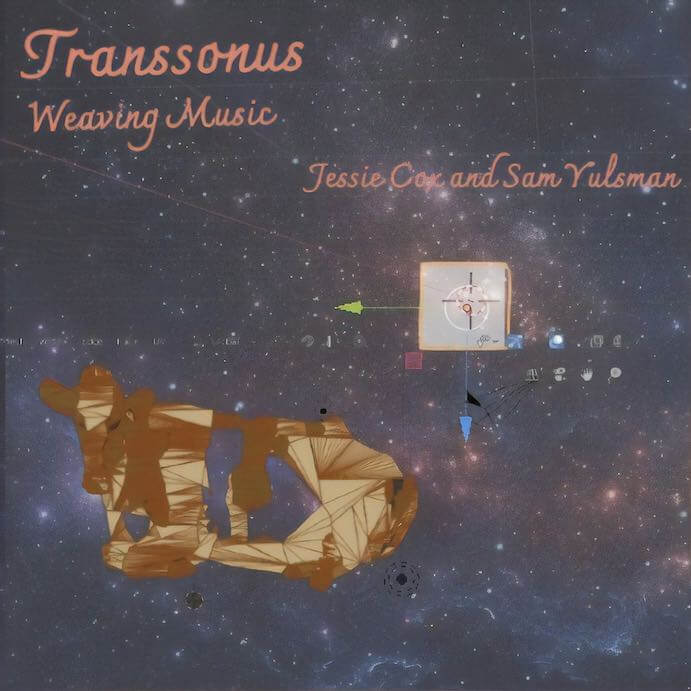Transsonus is the experimental duo of drummer Jessie Cox and pianist Sam Yulsman. Their debut album, Weaving Music (Gold Bolus Recordings), is an “experimental approach to jazz, classical, and electronic music traditions.” However, Weaving Music is not an album that juxtaposes three different styles, but instead blends all three into a combination that is something new entirely. Recorded and mixed at Columbia University’s Computer Music Center, Transsonus makes full use of the instruments and textures at their disposal without overstuffing the music. Every choice is economical in the sense that each individual track grows from a single cell without much interference, a remarkable feat for music that seems to be primarily improvised.

Transsonus–Photo by Gaya Feldheim Schorr
Case in point is the first track, “Noises and Sounds are Sonus,” which begins with a sparse rattling of rims and shells on the drumset, sometimes punctuated by the drums themselves. This builds on its own before the introduction of an electric organ more than a minute into the work. Cox and Yulsman increase the tension by slowly adding more and more elements, but instead of releasing the crescendo into a flurry of energy and volume as one might expect, they pump the brakes into an organ solo that is the analog to the initial drum material. What is striking about this solo is that, at times, the sound of the keys being struck is louder than the instrument itself. Like the playing of the rims earlier, this adds an intensity and directness to the track that would otherwise be missing. Out of the organ solo grows something more frantic and exciting–which one might have expected to happen earlier–before all of the energy dies away into extended organ chords and cymbal swells.
Transsonus is joined on the third track, “Anatomy of an Instrument,” by vocalist Bethany Younge. Over a percussive sound world that is similar to the opening of the first track, Younge speaks, “Now that this has been clarified, we can now put our leg into a simple step. Can you imagine? So, as we walk with our single leg and our single step, I can promise you that we will tumble. And in this tumble, our leg will grow.” Rim rattles and drawn out chords on various keyboard instruments grow amidst vocal sputters and shouts until an ultimate climax about eight minutes in. However, Younge’s yells and screams followed by syllabic sputtering are such an inevitable choice that the keyboards end up attracting more attention from the listener. Younge is much better equipped in the later track, “Spooky Action at a Distance,” which is sparser and allows her to explore the sonic space and clear room for herself.

Bethany Younge–Photo courtesy www.bethanyyounge.com
Featuring Dani Dobkin on the synthesizer, “LoFi-Airway” has much of the same frenetic energy as previous tracks, but as the title of the album suggests, this energy is intricately woven within itself. The constant static and noise from the synthesizer give Cox and Yulsman a chance to explore different instrumental combinations without having to worry about filling space. There are times where the piano is being played more like a drum, immediately followed by a texture that is more plaintive. It’s in these moments that Weaving Music really shows off what Transsonus is capable of: music that is both jagged and aggressive, while leaving room to be thoughtful and sweet.
“Transsonus is a ritual weaving of the music that binds us to each other, to our pasts, to ourselves.” This quote from the album’s press release can mean so many things: it can refer to the way in which music both links us to our past and heritage and propels us into the future, but it can also refer to Transsonus’ literal performance process. Jazz, abstract electronic, and classical idioms are all referenced in a streamlined group composition. Experimental music of this kind often runs the risk of being too self indulgent and meandering on endlessly, but Weaving Music is well constructed from beginning to end. There are a few moments where Cox and Yulsman rely on or reference tropes from abstract improvised music perhaps a bit too often, but the creative energy that is constantly bubbling underneath the surface is enough to forgive this. It’s a shame that Weaving Music is a digital-only release–the album is such an evocative collection of music that a physical experience, one with artwork and liner notes, could only enhance it.





















